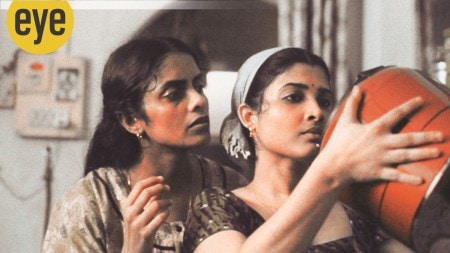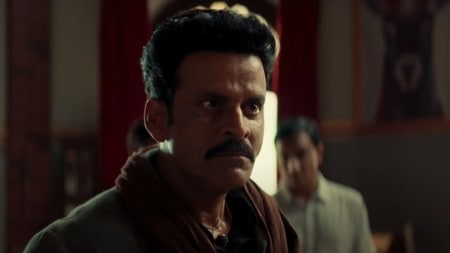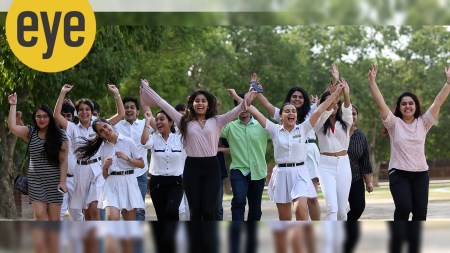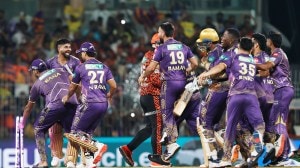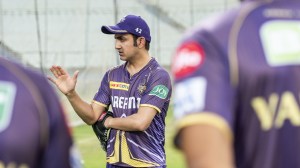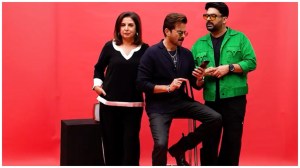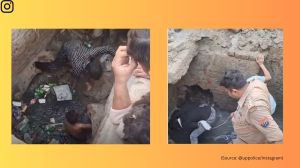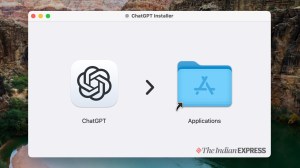- India
- International
Gujarat Speaker on live-streaming Assembly proceedings: ‘We are thinking about it … Nothing from govt saying don’t do this’
As Gujarat Assembly goes paperless, Shankar Chaudhary says the National e-Vidhan Application (NeVA) project is a “big digital revolution”.
 Chaudhary, 52, has been an MLA since 1998 and held ministerial portfolios such as health and urban affairs.
Chaudhary, 52, has been an MLA since 1998 and held ministerial portfolios such as health and urban affairs. Last week, the Gujarat Assembly became the 10th in the country to go digital following the launch of the National e-Vidhan Application (NeVA) by President Droupadi Murmu. In an exclusive interview with The Indian Express, Speaker Shankar Chaudhary talks about the Assembly’s transition to a paperless one, the challenges it faced, and why he thinks the Gujarat Assembly stands out among the states that have implemented NeVA.
Chaudhary, 52, has been an MLA since 1998 and held ministerial portfolios such as health and urban affairs. He is also the chairman of Banas Dairy, which is considered to be Asia’s largest dairy cooperative. He spoke about the cooperative’s sustainability programmes, including a joint project with Suzuki Motors to produce fuel from cow dung.
Excerpts:
What are your observations on the NeVA experiment?
In the beginning, we thought it would take time to get used to it. But in these three days (since its launch), most of the MLAs and ministers have begun using it and that is very satisfying for me. They are taking a keen interest and constantly trying to learn, whether it is uploading documents or question-answers.
What major differences has it made?
One is that earlier (the MLAs) would get the (question-answer) booklets after coming (to the Assembly). Now, they get the information in advance so they can prepare the sub-questions. Second, issues can be raised by researching the Bills. They have a tablet at home and the debates are now more informative. The new laws that we have passed in the last two days, (MLAs) are able to study laws across the world, what is the situation of education in other states … The library, of course, has information but they have been getting information besides that. I see a big digital revolution.
Was there any initial hesitation on the part of the members?
In the beginning, some people were concerned whether they could learn or not. But when the training happened, they realised it was easy. And it is in a very simple Gujarati language. The feel (of using the iPad) is like opening a page and using a pen. They all have links to the entire Constitution, which we have uploaded in Gujarati, the rules of the House, the decisions of the Speaker, everything is there. Not one MLA has said, ‘I am facing problems, I cannot do it.’

 A file photo of Gujarat Speaker Shankar Chaudhary, the MLA from Tharad, in Gandhinagar after his appointment to the post last December. (Express Photo)
A file photo of Gujarat Speaker Shankar Chaudhary, the MLA from Tharad, in Gandhinagar after his appointment to the post last December. (Express Photo)
Was the technical staff specially recruited?
We outsourced the training staff from NeVA. They first trained the Vidhan Sabha employees. Then, they trained the ministers’ personal assistants and secretaries, the senior officials, and then MLAs. Now, a total team is ready.
Inside (the House), we have kept six to seven technical staff but outside there are 12. There is a NeVa centre. In other (states), it was less successful than here because of the training.
This is the 10th Vidhan Sabha to go digital under NeVA. How is Gujarat different?
Firstly, Gujarat has already started operations. Other states are also doing well but I like the way it is working here. Secondly, we did a demo of the draw (of lots) for the questions before implementation — whose questions will be placed on priority, even that was put online. Gujarat is the first to do that. The Lok Sabha team that came from NeVA said that they would implement this in other states.
In Gujarat, there are more young and more educated MLAs compared with other states. They have an eagerness to learn. There is a lot of curiosity. I feel this is the strength of our Assembly – the yearning to learn. Take the example of our senior MLA (and Minister of Finance) Kanubhai Desai. Even our Chief Minister got used to it from day one and started working. The entire ministry has started working.
I thought they would take three days to learn, so one day we held a demo Assembly. But it has picked up. A lot of paper will be saved. Earlier, you would have to come from your constituency with one or two questions, now you can work from there. Even when the Assembly was not on, there were starred and unstarred questions posed. Now, if they want to ask questions and seek answers from the government, they can easily do it from their constituencies.
Have the Legislative Assembly questions been coordinated with the departments as well?
It is 100% online. There is an e-file system that it is linked with. We are also thinking of connecting it to the public. For instance, the MLA gives access to say 1,000 people from rural areas so the issues of that area can reach the MLA via an application form sent from mobile phones. We process that application through the Vidhan Sabha to the government. We are developing such a system. If that comes through, there will be accountability. Their files can be tracked. It will be easy to make the budget based on data analytics, and now we can also use (artificial intelligence). This will be a part of NeVA and this will be copied by the entire country.
Was this possible because of the robust power distribution network and Internet connectivity?
This is our biggest strength. When Narendra Modi ji was the chief minister, his first task was to provide optic fibre connectivity in every village and 24-hour power supply under the Jyotigram Yojana. Both of these are our strengths. Every village has a 4G network.
If one has to bring transparency, there has to be a faceless system — the work gets done without the person being seen. The MLA can do it using technology. There will also be accountability. By way of data, it will be clear which MLA is more active and what are the problem areas.
Do you foresee resistance from the MLAs?
No. They must work anyway. There is always competition to get more work done in their areas. I have also developed a positive culture for some time, taking everyone along. Take for example this training (for NeVa). I started it with a batch of Congress and Aam Aadmi Party (AAP) MLAs and then BJP MLAs. I don’t see any problem as of now. If something happens later, that is a different issue. But there is also a sense that if they don’t keep pace, the world will move ahead. So, they are working hard.
When will the Gujarat Assembly begin live streaming so that the people can watch their representatives perform? Can we expect it in the next session?
We are thinking about that as well … I cannot say exactly when, but we are thinking about it.
Are there any obstacles to live streaming?
There is nothing from the government saying don’t do this, but there are some aspects. The more trained the MLAs are, their image will be that much better … Many times we watch scenes from the Pakistan Assembly here online — the maara-maari (fighting). It not only spoils the image of the Assembly or the MLA but also of the entire country. We also should have (live streaming), but if something like this happens, it causes damage to the entire state, the country. I don’t think the (reasons) are anything more than this.
But many other Assemblies are already live-streaming.
It will happen here too. Of course, I have already readied the YouTube (channel) and the website we have developed through NeVA, but there are some limitations … We will sit with the information department and do (live streaming) too.
Can we assume there will be stricter laws, like you said that the MLAs need to stay within a limit?
No laws but self-discipline is the best thing and this can come about from training. As soon as the MLAs were elected, we held a workshop for three days and now we did this technology training. First, the MLAs said, ‘Why should we learn?’ But now they accept that we too must learn and stay updated. That is a positive thing.
In the future, we will bring in training modules for how our behaviour should be, how our capability can get better, what is our responsibility, what are our duties, where is the world going, how we prepare ourselves, how we manage our time and how do we increase productivity. And then we can become an ideal Assembly and then people can watch us. Even today, the scenes in our Assembly are quite good. This is the third session in my term, and we have not had to adjourn any session.
Is the Assembly disciplined because of the large number of BJP MLAs?
That may be possible but as the generation changes, their behaviour changes, and that must be accepted. I feel this is the biggest strength of our parliamentary system.
Seventy per cent of our MLAs are from the new generation, be it Congress or AAP, but in the BJP the number is higher. Earlier, they would talk about roti (food), kapda (clothes), makaan (housing). Now, the discussion has gone beyond that. Sometimes they also discuss the happiness index … I am seeing this change, this is progress.
What has changed since you first came to the House as an MLA in terms of the space given to the Opposition?
The time given to an MLA to speak in an Assembly is as per the strength of the party but they would have to be within the scope of discussion. When the BJP was in the Opposition, it would also feel that it should get more time. Now, the Congress is in the Opposition so it feels it should get more time.
What is the expected outcome of Banas Dairy’s memorandum of understanding with Suzuki Motors?
This is a big step toward sustainability. There was no vision on how to utilise cow dung, which has gas and nutrients for the soil. One cow produces 15-20kg of dung daily. A common man can run his vehicle for 50-100 km with the gas produced from this. If we use this, we can completely stop importing gas.
Banas Dairy researched this with the help of Indian Institute of Technology (IIT) and Indian Institute of Management (IIM) students and found that we can recreate the land that existed 100 years ago in three to four years with the combination of cow dung, cow urine, and leaf mulch.
Banas Dairy installed the first such CNG pump in India based on this research as part of a pilot project three years ago. We sell (a unit) at a rupee less (than other outlets) and the average (mileage) is good. We are buying dung at Re 1 per kilogram from the farmer. Suzuki had observed this over the last one-and-a-half to two years and then said it wanted to work with Banas Dairy.
They told us to give the farmers their due and that we would share the profit. We will provide the land and investment (of around Rs 250 crore) and (Suzuki) will work in a public-private partnership mode.
We are building four new plants with eight CNG pumps in Banaskantha and will also provide liquid and solid fertiliser. We aim to run the entire district on cow dung — no diesel or petrol. This is the revolution we are trying to bring from one district.
We are also planting trees on the borders of the farms to create mulch. Earlier, we would plant neem, mango and jamun but now we are planting sandalwood. On the Prime Minister’s birthday, we will plant one lakh sandalwood trees. We will build a forest of sandalwood in Banaskantha. One 10-15-year-old sandalwood tree costs nearly Rs 1 lakh. So, if one has a small farm of even 100 trees on the border it will be like a deposit for (farmers’) children. If they plant today, after 10-15 years, they can get a crore of rupees.
Won’t it be difficult to protect them?
Yes, theft is an issue. But every farm in the entire district will have them. Each sapling costs Rs 250-300 but we have got it at subsidised rate from Andhra Pradesh and will give it to each farmer for Rs 30 a sapling. The mulch will be from sandalwood leaves and this district will become like a lung on the border of Rajasthan and Gujarat.
Your government has not been able to enact the law on stray cattle. What is the solution according to you?
My job is to clear Bills within the ambit of the law. The solution is social awareness. More than milk, which it produces twice a day, our cows produce dung three to four times a day. They can create an income from the dung and then nobody will abandon cattle. I do see a way out. It is a problem in the cities and something will have to be done.
May 26: Latest News
- 01
- 02
- 03
- 04
- 05



